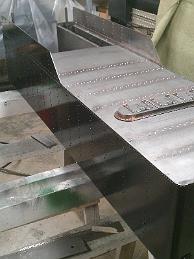 Section 18 - Tender
Section 18 - TenderLessons in steel tank coatings. 2015 Added the "doghouse" - the brakeman's shack to the tender deck, a unique Frisco detail, and backup light. 2014 - Finished over the winter and in service! Some detail work remains. The July 2013 Assembly continues, riveting and welding are in progress. I have already learned one lesson: Cut the tender frame to length AFTER the tank is made. Maybe you will do better than I did, but my tank is a about 1" shorter than planned making accurate bends in the sheet sides is hard! After using a borrowed tender for the first fire up of the locomotive, all attention is turned to fabricating one this winter. November 2012 - raw stock for Tender Frame cut. Steel side sheets for tender tank laser cut. Fiberglass Tender received 2003. June 2009 - I decide to make a tender instead of using the fiberglass one since the 3 axle trucks I have will not fit under the frame.


